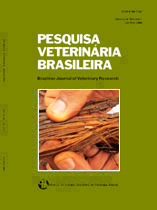 |
|
|
|
Year 2013 - Volume 33, Number 6
|

|
Effect of shearing on the skin temperature and other clinical parameters in sheep, 33(6):817-825
|
ABSTRACT.- Mendes L.C.N., Matsukuma B.H., Oliveira G., Peres L.C.T., Gerardi B., Feitosa F.L.F., Perri S.H.V. & Peiró J.R. 2013. [Effect of shearing on the skin temperature and other clinical parameters in sheep.] Efeito da tosquia na temperatura corpórea e outros parâmetros clínicos em ovinos. Pesquisa Veterinária Brasileira 33(6):817-825. Departamento de Clínica, Cirurgia e Reprodução Animal, Faculdade de Medicina Veterinária, Universidade Estadual Paulista, Rua Clóvis Pestana 793, Araçatuba, SP 16050-680, Brazil. E-mail: lmendes@fmva.unesp.br
The aim of this study was to determine the variation of the temperature after shearing in sheep under dry and hot environment conditions and to compare the temperature changes with variation in cardiac and respiratory frequencies, ruminal movements and hydration status. Twenty Suffolk unshorn ewes were studied. Physical examination was performed in all animals three times a day at 7:00 AM, 1:00 PM and 7:00 PM, during 42 days (22 days before shearing and 20 days after shearing). The skin temperature was measured by infrared thermometer over several surfaces of the body. Data were submitted to analysis of variance, for comparisons between groups (shorn versus unshorn) at each time, and the significant difference was evaluated at level of P<0.05 by Tukey test. The respiratory frequency was statistically significant at all times. When air humidity was high, the respiratory frequencies were low. The thermal stress was clear in sheep of this study, reflecting marked changes in cardiac and respiratory frequencies and rectal temperature. The respiratory frequency was the parameter more reliable to establish a framework of thermal stress in the unshorn sheep, with values on average three times higher than those reported in the literature. The heart rate monitors the thermal variation of the environment and is also an indicator of heat stress. This variation shows the Suffolk breed is well adapted to hot climates. The correlation between the body surface temperatures with environment temperature and air humidity was negative, as explained by the effect of wool insulation, i.e. even with an increase in environment temperature and humidity, the body temperature tends to maintain a compensating balance. In the shorn animals, the correlation between skin temperature with environment temperature and air humidity showed that the skin temperature increases when the environment temperature increases. The increase in the environment temperature does not affect the body temperature of unshorn animals due the insulating effect of the wool. However, when environment temperature rises, the presence of the wool starts to affect the thermal comfort as the heat absorption is larger than the capacity of heat loss. In this study, the best thermal stress indicators were the respiratory frequency and rectal and skin temperatures. The temperatures of the skin measured at the perineum, axillae and inner thigh were considered the most reliable. |
| |
|
|
| |
|
 |